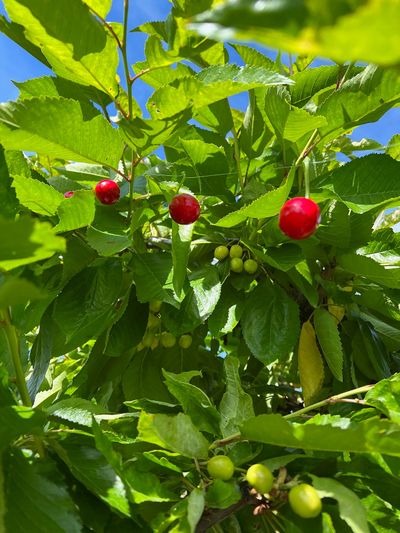In the Garden: A little trickery can keep the birds away from the fruit on the trees

My husband, Bill, and I really enjoy growing tree fruits. Our small orchard consists of apple, plum, pear, cherry and peach trees. Cherries in particular are commonly targeted by birds. We have had to get creative over the years in order to protect our highly coveted crop.
Anyone who has grown cherries knows that the fruits remain green and hard for most of the growing season. The birds tend to ignore them until the cherries turn color and then it’s a free-for-all.
Long before those fruits mature, we bring out what we jokingly refer to as the “party decorations.” They consist of tall metal or PVC poles that are topped with varying lengths of 3-inch-wide mylar flash tape. We strap the poles to the tree trunks and whenever the wind blows, the tape rustles and flashes brightly in the sun.
Next, we wrap our largest tree in bird netting. This involves a giant piece of netting, ladders, long poles, colorful language and a review of our medical co-pays. Between the party decorations and the netting, we have managed to limit bird damage.
This year, Bill decided to skip the bird netting and try something new, in an effort to convince them that our orchard wasn’t worth visiting.
He ordered artificial cherry fruits online that are incredibly realistic. Even though they are primarily sold as decorations, Bill thought they would make excellent decoys. His plan was to string the cherries on monofilament line and drape those strings in our cherry trees while our fruits were still green.
You may have heard about gardeners trying to fool robins by painting stones red so they look like strawberries. The idea behind this is if a robin pecks at a red stone long enough, they quickly decide there aren’t any fruits for them to feast upon and go elsewhere.
Bill’s artificial cherry plan worked the same way. No sooner did he hang those strings of cherries than the robins showed up, pecked on the fake fruits and – for the most part – went off to sulk about the lack of juicy fruits.
While harvesting ripe cherries, we noticed an occasional bird peck but it was nothing like the damage we usually have to endure. I have to admit that I occasionally reached for an artificial cherry, thinking it was the real thing, only to be surprised by how hard it was.
We also grow small fruits such as raspberries and blackberries. For the most part, we’ve just used the mylar flash tape to keep the birds away and it works pretty well. There’s also a type of flash tape that buzzes when the wind hits it.
To protect our blueberry crop, we’ve found that a physical barrier works the best. Years ago, we put bird netting over the bed. While it did keep out the birds, the berries easily got caught in it. Whenever we lifted the netting to pick them, berries would fly off in every direction.
A few years back, I sewed together some long pieces of floating row cover so it would be wide enough to cover the entire bed. We always wait until there are full-sized green berries before covering the bed and weighing down the edges with rocks. It is really effective.
While Bill and I are avid birdwatchers, we do draw the line when it comes to keeping birds away from our favorite crops to harvest.
Susan Mulvihill is author of “The Vegetable Garden Problem Solver Handbook” and “The Vegetable Garden Pest Handbook.” She can be reached at Susan@SusansintheGarden.com. Watch this week’s video at youtube.com/susansinthegarden.